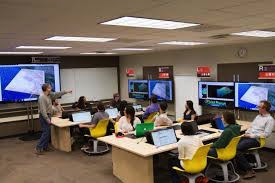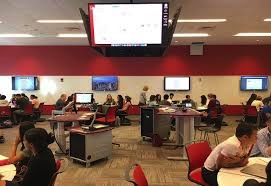EDUCAUSE 2016
Highlights
Susan Cain, Chief Revolutionary and Co-Founder, Quiet Revolution
 One third to one half the population are introverts, who often make self-negating choices to fulfill extroverts expectations. We need to let introverts do what they do best, especially in leadership and creativity. Extroverts thrive in busy, loud, stimulating environments, while introverts do better when quiet and alone. Note that the transition of classrooms from rows to pods favors the extrovert group think paradigm. Same with open office environments. When people gather they instinctively mirror the opinions of others in the room, especially the most charismatic and dominant. Five to 10 % of the group accounts for 90% of the talking. Even though there is zero correlation between being the best talker and having the best ideas. Group brainstorming not as effective as individual brainstorming. Stop the madness for constant group work. See her TED talk
One third to one half the population are introverts, who often make self-negating choices to fulfill extroverts expectations. We need to let introverts do what they do best, especially in leadership and creativity. Extroverts thrive in busy, loud, stimulating environments, while introverts do better when quiet and alone. Note that the transition of classrooms from rows to pods favors the extrovert group think paradigm. Same with open office environments. When people gather they instinctively mirror the opinions of others in the room, especially the most charismatic and dominant. Five to 10 % of the group accounts for 90% of the talking. Even though there is zero correlation between being the best talker and having the best ideas. Group brainstorming not as effective as individual brainstorming. Stop the madness for constant group work. See her TED talk
Transforming Learning at the Intersection of Cognitive Computing and Cognitive Neuroscience
“Rapid advances in AI, computer interactivity, and cognitive neuroscience hold major implications for understanding human cognition and are affecting all forms of learning (formal, nonformal, and informal). In this talk, we will explore the use of the IBM Watson suite of technologies to transform adaptive learning though deeply interactive and immersive tutoring experiences, which we hypothesize will improve learning outcomes across the entire spectrum of learning.”
Combining IBM’s cognitive capabilities with Pearson’s digital learning products will give students a more immersive learning experience with their college courses, and an easy way to get help and insights when they need it, all through asking questions in natural language just like they would with another student or professor. Importantly, it provides instructors with insights about how well students are learning, allowing them to better manage the entire course and flag students who need additional help.
For example, a student experiencing difficulty while studying for a biology course can query Watson, which is embedded in the Pearson courseware. Serving as a digital tutor, Watson will assess the student’s responses to guide them with hints, feedback, explanations and identify common misconceptions, working with the student at their pace until the topic is mastered.
Virtual Reality in the Classroom
Well, sort of. Mostly they talked about the Cave and the Yurt — too big to fit in a class. But also Google Cardboard, in particular the New York Times app giving students a different perspective on the news.
The Future of Learning
Sugata Mitra Professor, Educational Technology, School of Education, Communication & Language,Newcastle University
Funny, self-effacing, brilliant. See his TED talks.
“(He takes us) through the origins of schooling as we know it, to the dematerialization of institutions as we know them. Thirteen years of experiments in children’s education provide a series of startling results—children can self-organize their own learning, they can achieve educational objectives on their own, and they can read by themselves. Finally, the most startling result: groups of children with access to the Internet can learn anything by themselves. Studies in the slums of India; the villages of India and Cambodia; poor schools in Chile, Argentina, Uruguay, the United States, and Italy; the schools of Gateshead; and the rich international schools of Washington and Hong Kong produced experimental results that show a strange new future for learning. Using the TED Prize, Mitra has now built seven “Schools in the Cloud,” glimpses of which he will provide.”
In real life, we have google. We have the internet. We can ask a group of 9-year olds, Can something be in two places at the same time?” and get back an answer, “Have you heard quantum superpositions?” Why then do faculty ban internet usage during exams?
The teacher’s role is to encourage, prompt and then to lead a session where the children report back. In developing countries, with teachers in short supply, that role can be performed by someone else, including a British grandmother with a Skype connection. Though many of those involved are young locals, this became known as the “granny cloud”.


Seeking Evidence of Impact: Methodologies in Teaching and Learning
“Benchmarking and collecting evidence of impact is important in any undertaking. In this respect, postsecondary teaching and learning presents a unique set of challenges and complexities, so the key is to identify those methods that will produce useful and actionable results. This session will consist of overviews of evaluation and research techniques and methods in three important domains in teaching and learning: online and blended learning, classrooms and learning spaces, and the LMS. We’ll conclude the session with a discussion with our domain experts about the relative strengths of the approaches they presented and considerations with respect to implementing them.”
They presented their toolkit. I have a copy, will try to read.
The University of Wisconsin-Milwaukee established the National Research Center for Distance Education and Technological Advancements (DETA) to conduct cross-institutional data collection with 2-year and 4-year Institutions of Higher Education (IHEs) with the goal of fostering student access and success through evidence-based online learning practices and technologies. Specifically, the Center will identify and evaluate effective course and institutional practices in online learning (including competency-based education) for underrepresented students. The three primary goals are to: 1) understand and determine distance education outcomes; 2) identify practices (instructional and institutional) that impact those outcomes; and 3) conduct rigorous, interdisciplinary, and standardized research to identify outcomes and influences for all students, including those with disabilities.
With the carefully-established research model for distance education developed through a year-long process including a national summit of experts in the field, the next goal for DETA is to collect data at the course, program, and institutional levels to help DETA and other partners identify key factors at multiple levels for the purpose of informing future instructional practices. DETA developed research toolkits for the national DETA community to use, including evidence-based and exploratory operationalizations and definitions evolved from a multidisciplinary effort. These toolkits include several approaches including experimental and survey instrumentation collaboratively developed by DETA staff, DETA research fellows, UWM partners [Panther Academic Support Services (PASS) and Rehabilitation Research Design & Disability Center (R2D2)], institutional partners [Milwaukee Area Technical College (MATC), University of Wisconsin System Administration (UWSA), and University of Wisconsin-Extension(UW-E)], and national experts to ensure the methodology for data collection is flexible and properly adapted to best reach populations of interest.
Doing SharePoint Wrong Has Never Been So Right
Friday, October 28 8:00 AM–8:50 AM
Track: Innovating in IT Infrastructure and Cloud-Based IT Environments
The UVM College of Medicine broke all the rules of SharePoint deployment. Executive buy-in? Nope. Governance? Nah. Weeklong training? No way. New staff? None. We’ll tell our story of breaking the rules to make SharePoint easy to use and a go-to tool for our researchers and administrators.
Outcomes: Understand options for “dumbing down” SharePoint *Map pain points in their institutions to SharePoint solutions *Identify key cultural barriers to application adoption
Pamela James
Jill Jemison
I was 5 minutes late, the door was barred, the room was full, I was denied entry. Apparently, their talk was a resounding success.
Trending
Cloud Computing, SaaS (Software as a Service). Particularly Blackboard — several schools moving to that model. DropBox, Google Docs.
Active Learning spaces.
Synthesis
Consider a building full of active learning spaces, with devices of all sorts tied to the internet, as per Mitra’s Self-Organised Learning Environment, or SOLE.
Within a SOLE students are given the freedom to learn collaboratively using the internet. The Professor poses a Big Question and students form small groups to find an answer.
During a SOLE session students are free to move around and share information or to change groups at any time; towards the end of a session they have the opportunity to share what they learned with the whole group. SOLE sessions are characterised by discovery, sharing, spontaneity and limited teacher intervention.
“There should be chaos, noise, discussion and running about,” Mitra says. But there must be quiet spaces, too, to support Cain’s Quiet revolutionaries. See also Keeping Introverts in Mind in Your Active Learning Classroom.
Finally, the Professor is replaced (or supported by) a Granny Cloud of adjunct faculty or ultimately, Watsons.






